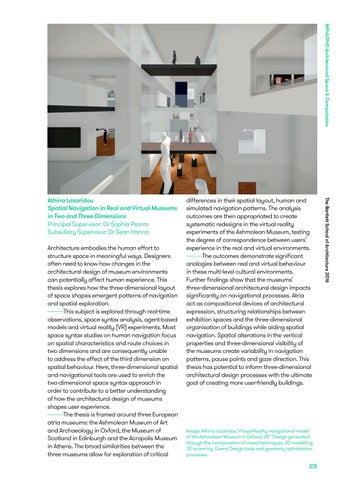MPhil/PhD Architectural Space & Computation
Architecture embodies the human effort to structure space in meaningful ways. Designers often need to know how changes in the architectural design of museum environments can potentially affect human experience. This thesis explores how the three-dimensional layout of space shapes emergent patterns of navigation and spatial exploration. This subject is explored through real-time observations, space syntax analysis, agent-based models and virtual reality (VR) experiments. Most space syntax studies on human navigation focus on spatial characteristics and route choices in two dimensions and are consequently unable to address the effect of the third dimension on spatial behaviour. Here, three-dimensional spatial and navigational tools are used to enrich the two-dimensional space syntax approach in order to contribute to a better understanding of how the architectural design of museums shapes user experience. The thesis is framed around three European atria museums: the Ashmolean Museum of Art and Archaeology in Oxford, the Museum of Scotland in Edinburgh and the Acropolis Museum in Athens. The broad similarities between the three museums allow for exploration of critical
differences in their spatial layout, human and simulated navigation patterns. The analysis outcomes are then appropriated to create systematic redesigns in the virtual reality experiments of the Ashmolean Museum, testing the degree of correspondence between users’ experience in the real and virtual environments. The outcomes demonstrate significant analogies between real and virtual behaviour in these multi-level cultural environments. Further findings show that the museums’ three-dimensional architectural design impacts significantly on navigational processes. Atria act as compositional devices of architectural expression, structuring relationships between exhibition spaces and the three-dimensional organisation of buildings while aiding spatial navigation. Spatial alterations in the vertical properties and three-dimensional visibility of the museums create variability in navigation patterns, pause points and gaze direction. This thesis has potential to inform three-dimensional architectural design processes with the ultimate goal of creating more user-friendly buildings.
Image: Athina Lazaridou,‘Virtual Reality navigational model of the Ashmolean Museum in Oxford, UK’. Design generated through the incorporation of mixed techniques: 3D modelling, 3D scanning, Game Design tools and geometry optimisation processes 315
The Bartlett School of Architecture 2016
Athina Lazaridou Spatial Navigation in Real and Virtual Museums in Two and Three Dimensions Principal Supervisor: Dr Sophia Psarra Subsidiary Supervisor: Dr Sean Hanna
